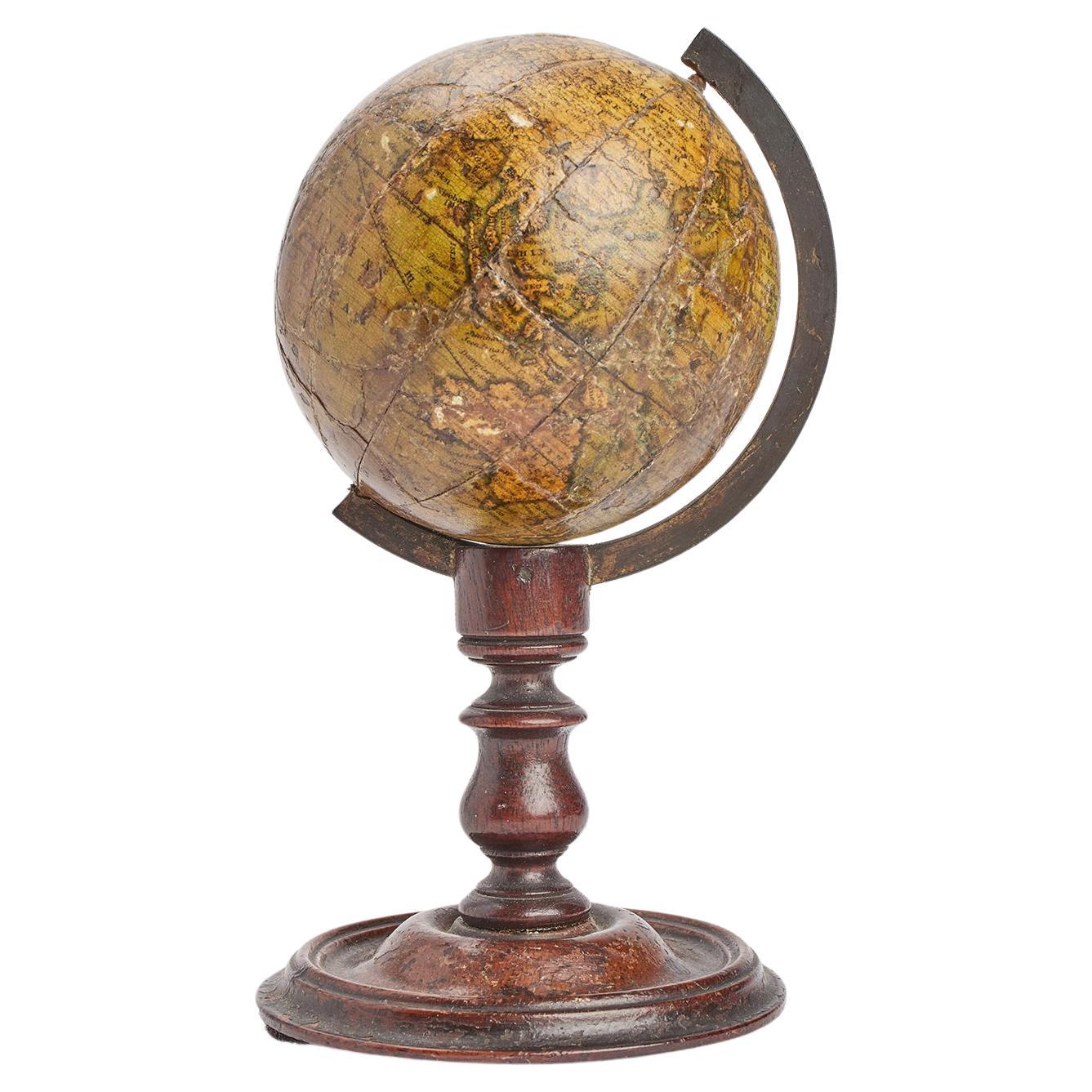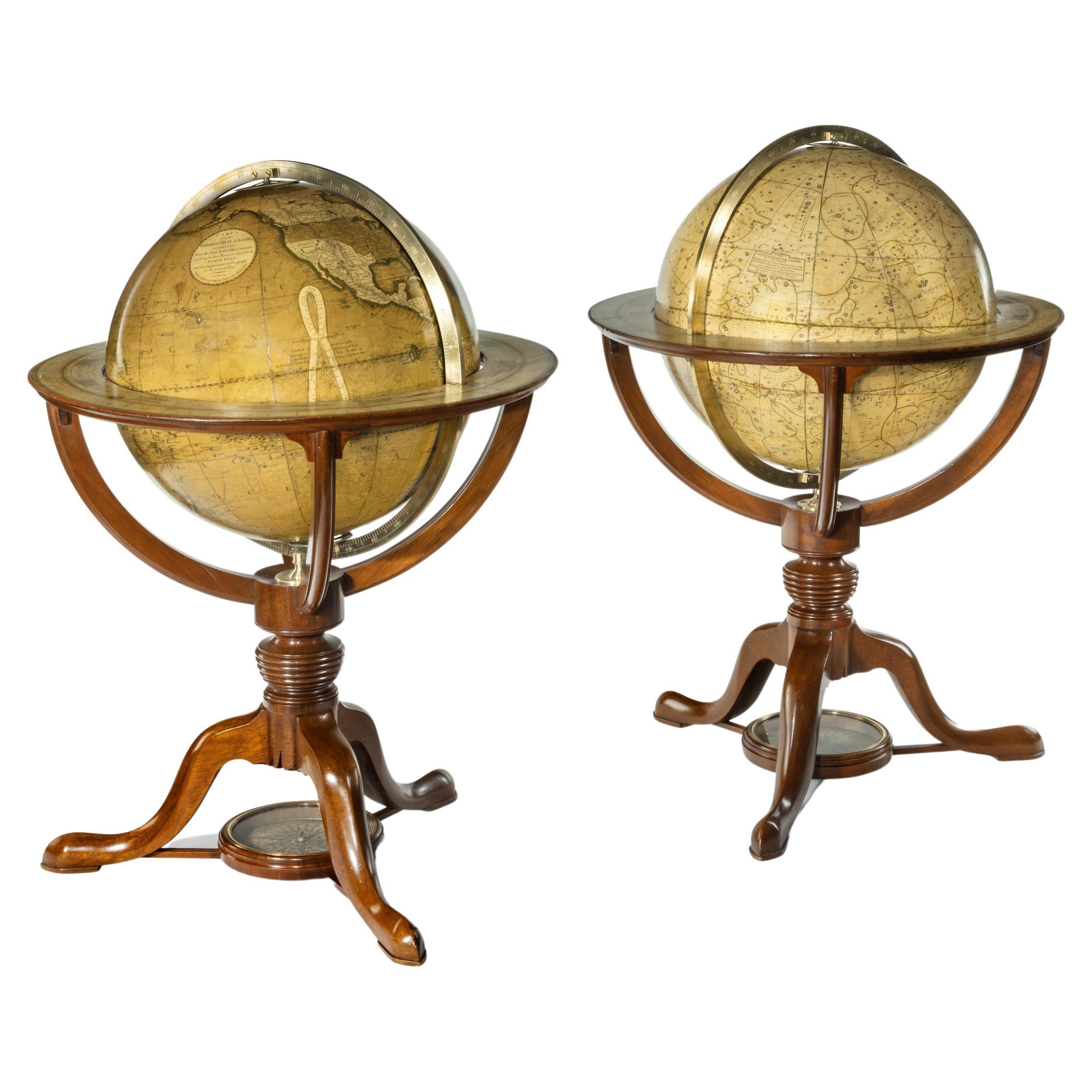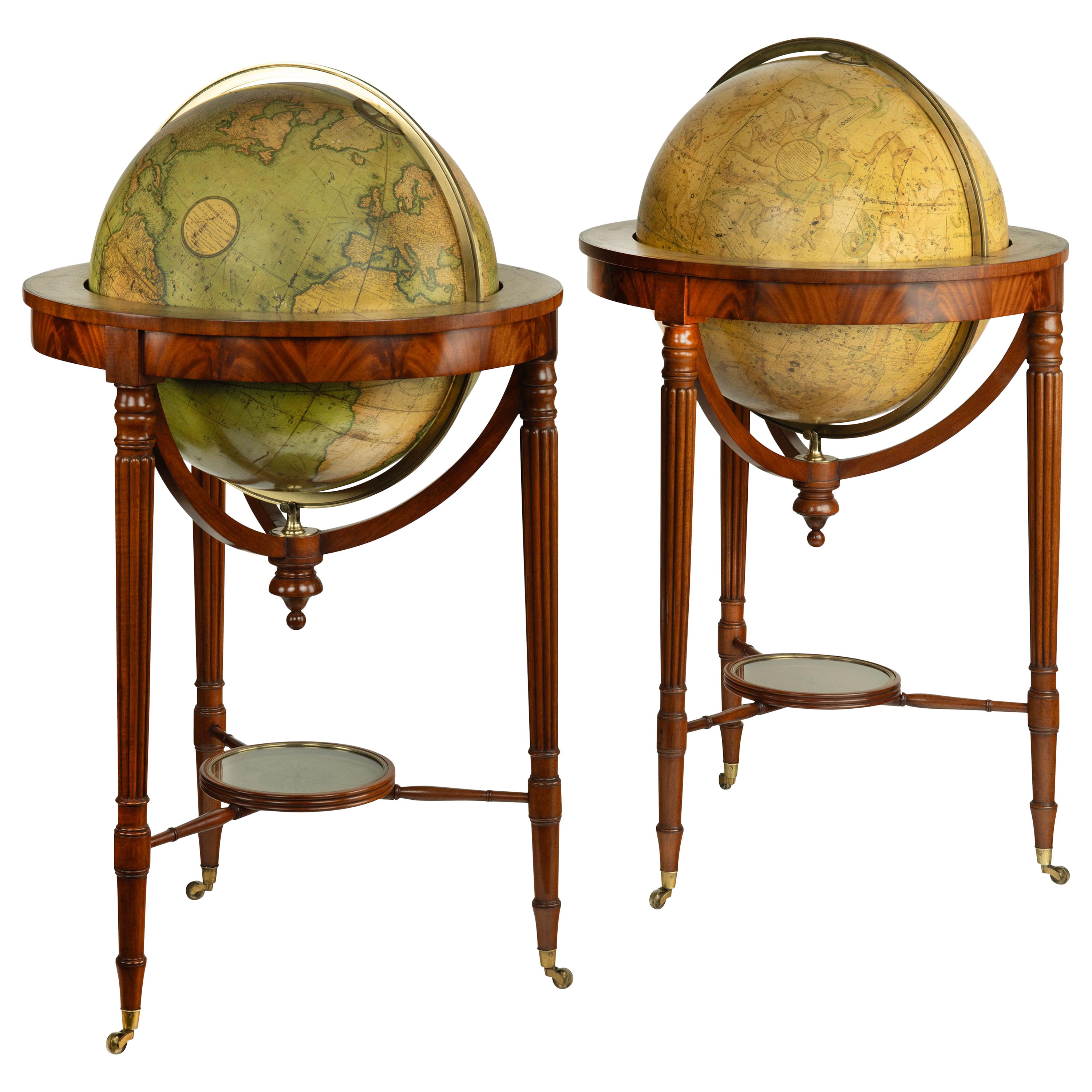Items Similar to Pair of Table Globes by J & W Newton, Dated 1820
Want more images or videos?
Request additional images or videos from the seller
1 of 5
Pair of Table Globes by J & W Newton, Dated 1820
About the Item
A pair of 12 inch table globes by J & W Newton, dated 1820, each with 12 hand coloured gores, graduated meridian rings, set within ebonised stands with three turned legs. The terrestrial globe stating ‘Newton’s New & Improved Terrestrial Globe embracing every recent Discovery to the present time. Manufactured by J & W Newton, 66 Chancery Lane, London. Published July 1820’ and the celestial globe stating ‘Newton’s New & Improved Celestial Globe whereon the stars are laid down from the most accurate observations of the best astronomers to the beginning of the year 1820.’ English, 1820.
- Creator:John & William Newton (Maker)
- Dimensions:Height: 19 in (48.26 cm)Diameter: 17 in (43.18 cm)
- Style:Regency (Of the Period)
- Materials and Techniques:Wood,Ebonized
- Place of Origin:
- Period:1820-1829
- Date of Manufacture:1820
- Condition:Wear consistent with age and use.
- Seller Location:Lymington, GB
- Reference Number:1stDibs: LU973025546642
About the Seller
5.0
Recognized Seller
These prestigious sellers are industry leaders and represent the highest echelon for item quality and design.
Established in 1982
1stDibs seller since 2013
106 sales on 1stDibs
Typical response time: 4 hours
Associations
LAPADA - The Association of Arts & Antiques Dealers
- ShippingRetrieving quote...Ships From: Lymington, United Kingdom
- Return PolicyA return for this item may be initiated within 14 days of delivery.
More From This SellerView All
- Fine Pair of Floor Globes by J & G Cary, Dated 1820 and 1833By George & John CaryLocated in Lymington, HampshireA fine pair of 15 inch floor globes by J & G Cary, dated 1820 and 1833, each set into a mahogany stand with a vase shaped support and three legs centred on a compass, one with a labe...Category
Antique Early 19th Century English Regency Globes
MaterialsMahogany
- Rare Pair of Table Globes by Cary, Each Dated 1816By John & William CaryLocated in Lymington, HampshireA rare pair of 9 inch table globes by Cary, each dated 1816. These globes are by John and William Cary and show the geographical and political borders drawn up following the Congress of Vienna. Each one is surmounted by a brass hour circle, within a calibrated full brass meridian, and a horizon band with an engraved paper calendar...Category
Antique 1810s English Globes
MaterialsBrass
- Pair of Table Globes by G & J Cary, Dated 1800 and 1821By George & John CaryLocated in Lymington, HampshireA pair of 12 inch table globes by G & J Cary, dated 1800 and 1821, each with hand-painted gores, set in mahogany stands with a turned support raised on three feet centred on the comp...Category
Antique Early 19th Century English Globes
MaterialsMahogany
- Pair of Table Globes by Josiah Loring, Dated 1844 and 1841Located in Lymington, HampshireA pair of 12 inch table globes by Josiah Loring, dated 1844 and 1841. Each globe is set into a fruitwood stand with four baluster turned legs and stretchers, the terrestrial globe wi...Category
Antique Mid-18th Century American Globes
MaterialsFruitwood
- A pair of mahogany Regency 21-inch globes by J&W Cary dated 1799 and 1819By Cary’sLocated in Lymington, HampshireA pair of mahogany Regency 21-inch globes by J&W Cary dated 1799 and 1819, the celestial globe with cartouche reading “CARY’S New and Improved CELESTIAL GLOBE ON WHICH is carefully l...Category
Antique 1790s English Regency Globes
MaterialsMahogany
- A pair of Newton and Son ‘New & Improved’ 15 inch globesLocated in Lymington, HampshireEach of these globes is set into a walnut stand with burr walnut veneers to the frieze and a solid turned and gadrooned walnut bluster support. This is raised on three acanthus carv...Category
Antique 1860s English Globes
MaterialsWalnut
You May Also Like
- A little terrestral globe by Newton, London 1820.Located in Milan, ITOver a round foot that rise with a central element with moved profile is connected the brass half meridian, which holds at the ends the metal axe of the little globe. The base is mad...Category
Antique Early 19th Century English Globes
MaterialsMetal, Brass
- Newton and Son Pocket Globe and CaseBy Newton and SonLocated in Spencertown, NYThe terrestrial globe is 3 inches in diameter contained within a turned mahogany box with cover. The seas in light green and land masses in darker green. Dimension of Globe 3" Diame...Category
Antique Mid-19th Century English Victorian Globes
MaterialsFruitwood, Paper
- Superb Pair of Delamarche Table GlobesLocated in Lincolnshire, GBA wonderful pair of 19th century table globes by Mansion Delamarche Paris, in superb original condition. The 12" globes in the original lacquered and gilt decorated stands.Category
Antique 1860s French Globes
- Pair of 19th Century Table Globes by CrunchleyLocated in Lincolnshire, GBA pair of 12" table globes by the well known map maker Crunchley, London. In the original and very smart mahogany stands. Circa 1865.Category
Antique 19th Century English Globes
MaterialsMahogany, Paper
- A pair of extremely rare Valk table globesBy Gerard and Leonard ValkLocated in ZWIJNDRECHT, NLTitle on the globes: VALK, Gerard and Leonard. [Terrestrial globe:] Cosmotheore, caelesti nostro globo, par, et plane novus, hic terrestris ut existeret, certo scias, errore veterum ...Category
Antique 18th Century Dutch Dutch Colonial Globes
MaterialsOther
- An exceptional pair of BLAEU table globesBy Willem BlaeuLocated in ZWIJNDRECHT, NLA very rare set of globes, 9 inch / 23cm, with an overall height of 38 cm, Amsterdam, dated 1602, but published after 1621. In their original stands with circular wooden horizon rings, covered with printed paper, supported by four legs and brass meridian rings supported by a single column. The terrestrial and celestial globe are made up of a set of 12 engraved gores, heightened in gold and Arctic ice caps, printed on paper and mounted on a plaster sphere of papier maché. Each sphere is mounted in a graduated brass meridian ring with the production number stamped at the back of the ring. Both globes are mounted on four-legged ebonized oak Dutch stands, which support the horizon ring. The legs are connected by two crossbeams which support a circular base plate with central support for the meridian ring. The horizon rings are covered with printed paper. With usual defects: paper equinoctial tables present gaps that are filled and restored; small splits along gores; several partially deleted entries; on the globe, the date 1602 and the text of the cartouche in America, are illegible ; small scattered spots but in general in good condition for such an early globe pair of which presently only 19 pair are recorded. These 9-inch globes are among the rarest since very few copies of them are known to exist, in comparison with the smaller or larger globes of Blaeu (4, 6, 13.5, and 26 inches). Blaeu's terrestrial globes were highly valued and were much in demand, because of the care with which they had been prepared, because of the efforts to give the latest information on discoveries, and because of the loxodromic lines that made them of special value to navigators. His celestial globes were appreciated for the fact that he had been the pupil of Tycho Brahe, who was himself known to be the greatest astronomer of his time. Willem Janszoon Blaeu (1571–1638), originally trained in astronomy, he quickly became a leading maker of maps, atlases and instruments. Blaeu’s globes were luxury items for wealthy and intellectual merchants and nobility who benefited from Blaeu’s access through the Dutch East India Company to the latest navigational discoveries and geographical information. Willem Jansz Blaeu collected information that Dutch mariners gathered from around world and brought back to Amsterdam. Crews were instructed to record information about the lands they visited and the skies they saw. Blaeu incorporated these observations in maps and globes. Through his web of contacts and thanks to assiduous research, he was also able to obtain the most recent information about the latest discoveries in the western hemisphere and the South Pacific, where Dutch explorers were particularly active at the time. Since the globe was published after 1618, Blaeu was able to include the discoveries made by Henry Hudson in his attempt to find a passage to the East Indies. He also included recent Pacific discoveries of the celebrated voyages of Willem Cornelis Schouten and Jacob Le Maire, who both traversed the South Pacific and the Atlantic. The findings of Schouten and Le Maire in the Tierra del Fuego region are also incorporated. The Strait of Le Maire is drawn and the hypothetical southern continent is labelled “Terra Australis Incognita Magalanica”. Olivier van Noort’s track is drawn and labelled. His route is indicated with a broken line and the words: “Navigationis Olivierij ductus” (several times). There are various decorative features, such as animals on the different continents, many ships on the high seas and allegorical and mythical figures around the cartouches. The nine-inch globe is not just a smaller version of the one published in 1599. Drawings of animals and people do often correspond to those on the earlier globe, but Blaeu made several significant changes. - The west coast of North America is drawn differently and the river system of Brazil is altered. - The hypothetical southern continent is labelled: Terra Australis Incognita Magallanica. - There are nine ocean names in handsome curling letters: Mare Congelatum, Mare Atlanticum, Oceanus Aethiopicus, Mare Arabicum et Indicum, Mare di India, Oceanus Chinensis, Mar del Zur, Mare Pacificum, Mar del Nort. - Willem Blaeu...Category
Antique 17th Century European Dutch Colonial Globes
MaterialsOther
Recently Viewed
View AllMore Ways To Browse
Manufactured Homes
Manufactured Home Used
Antique Accent Table
Antique Accent Tables
Accent Table Antique
Antique Accent Table Furniture
Antique Accent Tables Furniture
Accent Tables Pair
Pair Of Accent Table
Antique Wood Accent Table
Tables From 1820
Accent Table Set
Antique New England Homes
Antique Improver
Ring 1820 Ring
Ebonised Pair
Antique Lane Furniture
Antique Furniture Lane





